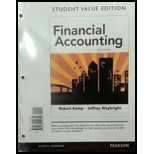
1.
a.
Determine the reason why does an inventory need to be counted.
1.
a.
Answer to Problem 1DQ
The inventory is counted in order to ensure that the inventory recorded According to the perpetual inventory, truly represents the inventory on hand.
Explanation of Solution
Perpetual Inventory System:
Perpetual Inventory System refers to the inventory system that maintains the detailed records of every inventory transactions related to purchases, and sales on a continuous basis. It shows the exact on-hand-inventory at any point of time.
1.
b.
Describe the situation that would happen if the count was done incorrectly.
1.
b.
Answer to Problem 1DQ
If the count was done incorrectly, it would either understate the ending inventory or overstate the ending inventory. This is because to match the physical count the inventory account is adjusted.
Explanation of Solution
Ending Inventory:
It represents the quantity and price of the goods unsold and laying at the store at the end of a particular period.
c.
Describe the terms FIFO and LIFO that has to do with inventory.
c.
Answer to Problem 1DQ
The terms FIFO and LIFO has the flow of inventory costs to do with inventory through the records of accounting.
Explanation of Solution
First-in-First-Out method:
In First-in-First-Out method, the costs of the initially purchased items are considered as cost of goods sold, for the items which are sold first. The cost of merchandise sold is calculated by adding all the total cost of merchandise sold during the month. The value of the ending inventory consists of the recent purchased items.
Last-in-Last-Out:
In Last-in-First-Out method, the costs of last purchased items are considered as the cost of goods sold, for the items which are sold first. The value of the closing stock consists of the initial purchased items.
Want to see more full solutions like this?
Chapter 5 Solutions
Financial Accounting, Student Value Edition (4th Edition)
 Intermediate Accounting: Reporting And AnalysisAccountingISBN:9781337788281Author:James M. Wahlen, Jefferson P. Jones, Donald PagachPublisher:Cengage LearningPrinciples of Accounting Volume 1AccountingISBN:9781947172685Author:OpenStaxPublisher:OpenStax College
Intermediate Accounting: Reporting And AnalysisAccountingISBN:9781337788281Author:James M. Wahlen, Jefferson P. Jones, Donald PagachPublisher:Cengage LearningPrinciples of Accounting Volume 1AccountingISBN:9781947172685Author:OpenStaxPublisher:OpenStax College Cornerstones of Cost Management (Cornerstones Ser...AccountingISBN:9781305970663Author:Don R. Hansen, Maryanne M. MowenPublisher:Cengage Learning
Cornerstones of Cost Management (Cornerstones Ser...AccountingISBN:9781305970663Author:Don R. Hansen, Maryanne M. MowenPublisher:Cengage Learning College Accounting (Book Only): A Career ApproachAccountingISBN:9781337280570Author:Scott, Cathy J.Publisher:South-Western College Pub
College Accounting (Book Only): A Career ApproachAccountingISBN:9781337280570Author:Scott, Cathy J.Publisher:South-Western College Pub




